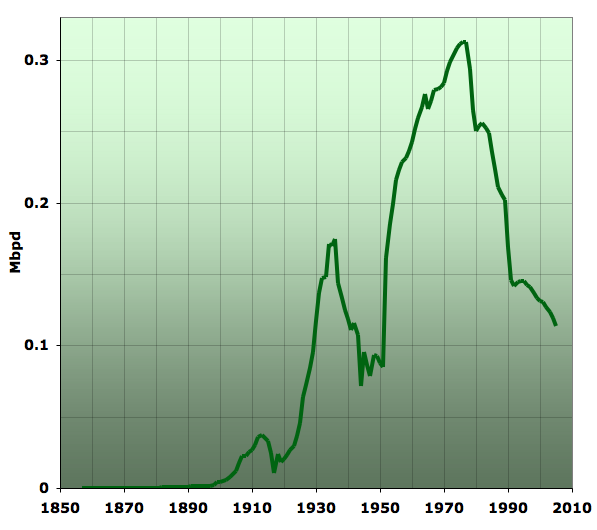Romania Oil Shock Model
Based on some intriguing results that Staniford posted at TOD regarding historical Romanian oil production, I thought I would compare it against the oil shock model. Staniford plotted against the production data (shown below), and effectively fit to the Hubbert Linearization method assuming a Gaussian shape.

This curve looks similar to one that Laherrere published (which also includes estimates of discoveries) :

(aside: note that Laherrere's discovery curve tries to "connect the dots" between years of discoveries, which has the unfortunate effect of indicating more earlier discoveries than are warranted; check his cumulative curve to get the right data)
As I mentioned on TOD's comment page, the model I use derives completely from stochastic considerations and so would generally apply more caution for someplace like Romania (or worse yet, France) as I worry about overlooking the heavy influence of deterministic effects. This comes about from a small sample size in these countries and asking whether one should apply to the maximum entropy estimator of equating the mean to the standard deviation on the rate random variables. In addition, since the Romania data crosses through a sweet spot that includes the years of WW2, one could imagine a huge perturbation occurring during that time.
In any case, I tried to keep the model as simple as possible and used means of 6 years for the fallow, construction, and maturation periods, and a 16.66% depletion rate for extraction (also corresponding to a 6 year 1/e time).

The oil shock model misses the actual reported peak by a lag of less than 5 years, but does catch up on the down slope. Earlier on in the production life cycle, the model does predict the two other significant peaks (corresponding to discovery deltas), but both the location and scaling remains way off. It almost looks as if much of the very early discovery estimates either did not deliver as much oil as predicted or, less likely, went to waste for whatever reason. Based on Laherrere's analysis that the cumulative oil production has not matched that from discoveries (see below), it would not surprise me if the "missing-in-action" pre-1900 discoveries account for the discrepancy.










4 Comments:
I always enjoy the periodic reappearance of your models.
I don't think you've ever done an Australian version - feel like giving one a workout ?
The closest I have come is New Zealand natural gas.
http://mobjectivist.blogspot.com/2005/11/new-zealand-natural-gas-peak-model.html
The main thing is getting good discovery data or estimates. I could try without the data (which seems lacking in Oz), but then take it with a grain of salt.
bes tsite
http://www.lindsaylohan.co.in/
http://www.lingeriesshop.org/
Lingeries Office lingeries office lingeries office womens lingeries lingeries pic
Hot Lingerieshot lingeries lingeries office womens lingeries lingeries pic,
Post a Comment
<< Home